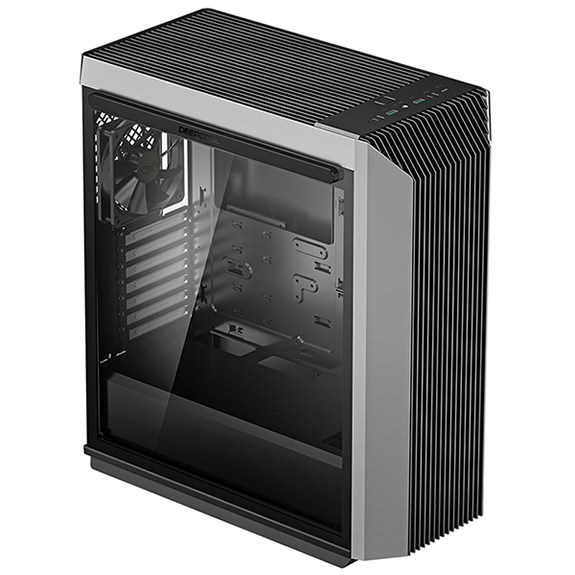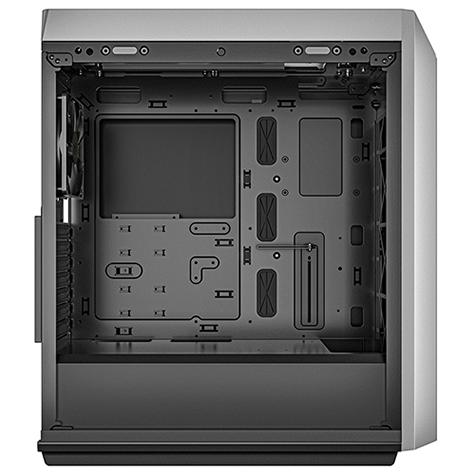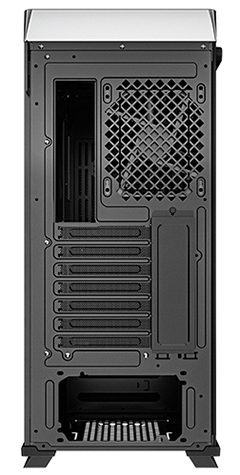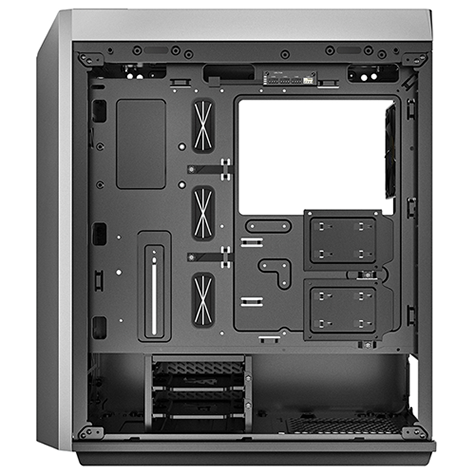Introduction
We're accustomed to seeing manufacturers make outlandish claims when marketing their products, so it is nice to see Deepcool take a more modest approach with its latest chassis, the CL500, which it describes as "a well-rounded PC case that values airflow performance and easy to build features."
Sounds a useful foundation for a late 2020 build and the £80 price tag is no major hurdle, so let's dive in and take a closer look.
First impressions are mixed. Some in the office quite like the minimalist, almost industrial exterior design, but I have my reservations. The light-grey top section makes the case appear top-heavy, and the whole chassis would appear sleeker with the glass side panel extending further to the roof of the case.
Dimensions of 473mm (L) x 226mm (W) x 519mm (H) are a little on the tall side compared to the Macube 310P built on the same underlying frame, however the black-and-grey colour scheme is tidy, there's no unnecessary RGB lighting, and the tinted side window lends a modern appearance. Hinged at the bottom and secured magnetically, the windowed panel is easily removed with a gentle tug, but can optionally be locked in place using brackets supplied in the bundle.
There's a modern feel to the top I/O panel, too, which includes a combination audio jack, a pair of USB 3.0 Type-A and forward-looking USB 3.1 Type-C. We'd prefer the power and reset buttons not to be identical in size and shape - it is far too easy to confuse one for the other - and just behind the I/O ports is a larger push-to-release button used to lift the top mesh cover away from the body of the case.
Those extra-large grille/mesh sections on the top and front are a key attraction for those who favour a high-airflow approach, though given the focus on cooling performance, we are surprised to find only a single fan included as standard; a 120mm rear exhaust powered either by a three-pin motherboard header or ol' fashioned Molex. Aware of this shortcoming, Deepcool has confirmed to HEXUS that specific retailers - including Scan Computers in the UK - will be bundling the case with a triple pack of the firm's CF120 Plus RGB fans. Total cost climbs to £100, representing a £30 saving when compared to buying the case and fans separately.
Should you choose to add your own fans, there's room for a further three 120s or two 140s in the front, plus two 120s in the roof. Plenty of cooling potential for most users, however the upper arrangement has left us scratching our heads. Behind the top grille, the radiator tray is a solid panel with a 240mm cutout. Not only does this hamper the chassis' high-airflow credentials, but it also limits top radiator support; we'd much prefer a mesh tray allowing for greater airflow, a choice of radiator sizes and offset mounting positions.
Elsewhere, we have room for either a mini-, micro- or regular-ATX motherboard, seven expansion slots, a shrouded PSU compartment, and four storage bays comprising of a two-bay hard disk cage and a pair of 2.5in SSD sleds fixed to the rear of the motherboard tray.
Deepcool ticks the essentials checklist with a trio of rubber-grommeted cable holes, as well as a pair of Velcro tie-down straps, and there's extra value in the form of a four-way PWM fan hub and a height-adjustable graphics-card bracket whose rotating arm does a fine job of eliminating the dreaded GPU sag.
Ample internal space and an absence of superfluous cabling makes the CL500 easy to work with, but you do notice that overall build quality leaves something to be desired. The plastic outer panels bend quite easily when flexed, the PSU area is lined with a basic mesh insert on the bottom as opposed to a pull-out filter, all the supplied screws are lumped together in a single bag, and the vibration-absorbing pads on the bottom are so thin they don't prevent the chassis from making contact with the desk.
In terms of component compatibility, graphics cards can measure up to 330mm in length, there's 165mm of clearance for a CPU cooler, and maximum PSU length is quoted as 160mm. We did have to move the hard-disk cage over a fraction in order to install our 750W be quiet! supply (the cage can't easily be removed entirely), but the chassis doesn't feel cramped and the 23mm of clearance behind the motherboard tray proved sufficient for our setup.
A safe bet at £80? Let's run the benchmarks before coming to a conclusion.








